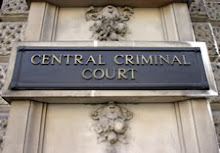Old Bailey: One hundred years of crime and punishment
China Daily 28 Feb. 2007
China Daily 28 Feb. 2007
The Queen and the Duke of Edinburgh visited the Old Bailey yesterday, marking the centenary of a court that has hosted some of the most dramatic cases in British legal history.
In its 100 years, it has dealt with infamous criminals such as killer Dr Crippen; World War II traitor "Lord Haw Haw" William Joyce; gangsters Ronnie and Reggie Kray and mass murderer Peter Sutcliffe, better known as the Yorkshire Ripper.
Formally known as the Central Criminal Court, but more widely known after the street in which it stands, the Old Bailey was opened by King Edward VII in 1907. It was built on the site of the notorious Newgate prison, once part of the walls of the city of London, which was in use from 1188 to 1902, and rebuilt after the Great Fire of London in 1666.
Prisoners were held there since 1783 before being executed and crowds used to gather outside the building every Monday to see the hangings. But public hangings were stopped in 1868, and the prison itself was demolished in 1904.
As a prime symbol of British justice, the Old Bailey came under attack from Irish terrorists in 1973 when a car bomb exploded in the street. The building escaped with minor damage after the German air force bombed the area during World War II.
The Queen and the Duke of Edinburgh were yesterday to view a display in the building's Grand Hall before meeting key court personnel.
Nothing can have given the Queen more satisfaction during her long reign than the Old Bailey. At a rough estimate, defendants who have stood in its fabled docks must have served tens of thousands of years "at her Majesty's pleasure" for murders, frauds, robberies and kidnappings. Many were unfortunate enough to hear a judge's stern command "take him down" after the jury foreman had delivered a guilty verdict.
Things have changed since 1910, when pieces of Dr Crippen's dead wife's skin were handed round the court in a soup-plate for inspection by jurors.
Today there are laptops and microphones where once there were inkwells and ledgers. And, since the abolition of the death penalty, the only black caps to be seen are of the baseball variety, usually worn by friends of the accused sitting in the public gallery.
The last person to be sentenced in the first hundred years of the fabled Court One was 26-year-old Jermaine Smith, who killed a man outside a takeaway outlet in Enfield after an argument that began after each accused the other of staring.
Not so penitent
Yesterday, Judge Ann Goddard jailed Smith for four years and three months for manslaughter after he expressed remorse through his counsel Nadine Radford, who assured the judge that what had happened was "totally out of character". Not all previous defendants have been so penitent. Legendary gangster Ronnie Kray told the judge at his trial for murder in 1968 that if he had not been required in court he would "probably have been having tea with Judy Garland".
Peter Scott, the "king of the cat-burglars", who cut a swath through Mayfair and country houses in the 60s and who is now retired and living in Islington, north London, recalled last night the poignant words inscribed on the prisoner's side of the door leading into Court One by one previous, regretful defendant: "A boy's best friend is his mother."
"I can concur with that," said Scott yesterday. "The Old Bailey has all kinds of mixed memories for me. There is a certain kind of nostalgia, and then I think about the wastage. I chose to be what is euphemistically called a cat-burglar but the reality is you spend years in prison and you end up in a dirty flat."
He will not be at today's ceremony. "I don't think people of my ilk are invited," he said.
Someone who has been invited is veteran court reporter David St George, who has been covering trials in the Old Bailey since 1969. He regrets that there is less of an appetite today for the detailed court reports that were once a staple of the daily press.
"I'm afraid the newspapers today are more interested in celebrities than trials," he said, recalling a time when the press room in the bowels of the court used to heave with members of the Fourth Estate.
St George said the cases that stood out during nearly four decades of reporting were those of Peter Sutcliffe, the Yorkshire Ripper and Jeremy Thorpe, the former Liberal Party leader who was acquitted of conspiracy to murder in 1979 and who, he recalled, arrived in court carrying a cushion because of the unforgiving nature of the bench seats in the Court One dock.
The present building was designed by EW Mountford, and has been memorialized in fiction by John Mortimer's Rumpole of the Bailey and, in its previous incarnation, by Charles Dickens' in A Tale of Two Cities.
It is still handsomely maintained and decorated with the words "Domine, Dirige Nos," imprinted on the court seats. The words can be translated as "Lord, direct us" or if you are coming up from the cells "God help us."
Many royals have visited the Old Bailey in the past. The Queen herself might well have paid an earlier visit had she chosen to be a witness in the trial of Princess Diana's butler, Paul Burrell, who was acquitted of theft in 2002.

No comments:
Post a Comment